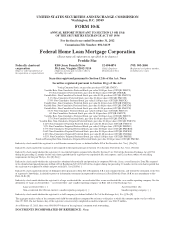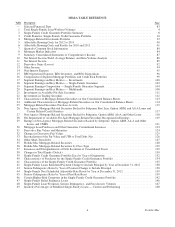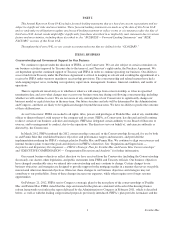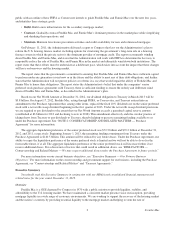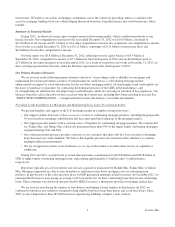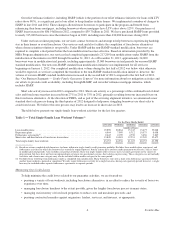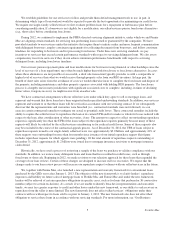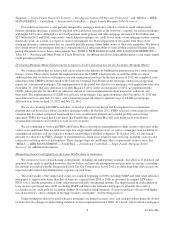Freddie Mac 2012 Annual Report Download - page 10
Download and view the complete annual report
Please find page 10 of the 2012 Freddie Mac annual report below. You can navigate through the pages in the report by either clicking on the pages listed below, or by using the keyword search tool below to find specific information within the annual report.We establish guidelines for our servicers to follow and provide them default management tools to use, in part, in
determining which type of loan workout would be expected to provide the best opportunity for minimizing our credit losses.
We require our single-family seller/servicers to first evaluate problem loans for a repayment or forbearance plan before
considering modification. If a borrower is not eligible for a modification, our seller/servicers pursue foreclosure alternatives
(e.g., short sales) before considering foreclosure.
During 2012, we continued to implement the FHFA-directed servicing alignment initiative, under which we and Fannie
Mae are aligning certain standards for servicing non-performing loans owned or guaranteed by the companies. We have
provided standards to our servicers under this initiative that require them to initiate earlier and more frequent communication
with delinquent borrowers, employ consistent requirements for collecting documents from borrowers, and follow consistent
timelines for responding to borrowers and for processing foreclosures. Under these new servicing standards, we pay
incentives to servicers that exceed certain performance standards with respect to servicing delinquent loans. We also assess
compensatory fees from servicers if they do not achieve minimum performance benchmarks with respect to servicing
delinquent loans, including foreclosure timelines.
Our servicers pursue repayment plans and loan modifications for borrowers facing financial or other hardships since the
level of recovery (if a loan reperforms) may often be much higher than with foreclosure or foreclosure alternatives. In cases
where these alternatives are not possible or successful, a short sale transaction typically provides us with a comparable or
higher level of recovery than what we would receive through property sales from our REO inventory. In large part, the
benefit of short sales arises from the avoidance of costs we would otherwise incur to complete the foreclosure and dispose of
the property, including maintenance and other property expenses associated with holding REO property. The foreclosure
process is a lengthy one in many jurisdictions with significant associated costs to complete, including, in times of declining
home values, foregone recovery we might receive from an earlier sale.
We have contractual arrangements with our seller/servicers under which they agree to sell us mortgage loans, and
represent and warrant that those loans have been originated under specified underwriting standards. In addition, our servicers
represent and warrant to us that those loans will be serviced in accordance with our servicing contract. If we subsequently
discover that the representations and warranties were breached (i.e., contractual standards were not followed), we can
exercise certain contractual remedies to mitigate our actual or potential credit losses. These contractual remedies include the
ability to require the seller/servicer to repurchase the loan at its current UPB and/or to make us whole for losses realized with
respect to the loan, after consideration of other recoveries, if any. The amount we expect to collect on outstanding repurchase
requests is significantly less than the UPB of the loans subject to the repurchase requests primarily because many of these
requests will likely be satisfied by the seller/servicers reimbursing us for realized credit losses. Some of these requests also
may be rescinded in the course of the contractual appeals process. As of December 31, 2012, the UPB of loans subject to
repurchase requests issued to our single-family seller/servicers was approximately $3.0 billion, and approximately 41% of
these requests were outstanding for more than four months since issuance of our initial repurchase request (this figure
includes repurchase requests for which appeals were pending). Of the total amount of repurchase requests outstanding at
December 31, 2012, approximately $1.2 billion were issued due to mortgage insurance rescission or mortgage insurance
claim denial.
Historically, we have used a process of reviewing a sample of the loans we purchase to validate compliance with our
standards. In addition, we review many delinquent loans and loans that have resulted in credit losses, such as through
foreclosure or short sale. Beginning in 2012, we made revisions to our selection approach for these loans that expanded the
coverage of our loan reviews. Certain of these changes are designed to increase our loss recoveries. We expect that the
changes made to our loan review process will increase our repurchase request volumes with our seller/servicers in the future.
We, together with Fannie Mae, also launched a new representation and warranty framework for conventional loans
purchased by the GSEs on or after January 1, 2013. The objective of the new framework is to clarify lenders’ repurchase
exposures and liability on future sales of mortgage loans to Freddie Mac and Fannie Mae and, under the new framework,
lenders will be relieved of certain repurchase obligations in specific cases, such as for loans that perform for 36 consecutive
months (subject to certain exclusions). As a result, if we are unable to identify breaches in representations and warranties
timely, we may face greater exposure to credit and other losses under this new framework, as our ability to seek recovery or
repurchase from the seller is more limited. The new framework does not affect seller/servicers’ obligations under their
contracts with us with respect to loans sold to us prior to January 1, 2013. The new framework also does not affect their
obligation to service these loans in accordance with our servicing standards. For more information, see “Our Business
5Freddie Mac

